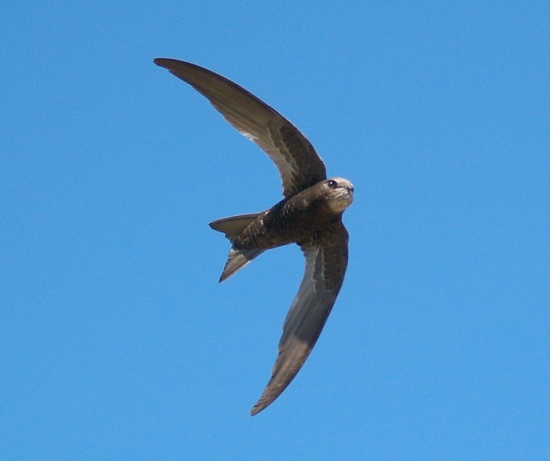(Photo caption. References) |
(In culture) |
||
| (One intermediate revision by the same user not shown) | |||
| Line 1: | Line 1: | ||
| − | {{ | + | [[Image:53334700Bradfields_Swift.jpg|thumb|550px|right|Photo by{{user|CollinBax|CollinBax}}<br />Welgemoed Dam, Cape Town, [[South Africa]], March 2007]] |
;[[:Category:Apus|Apus]] bradfieldi | ;[[:Category:Apus|Apus]] bradfieldi | ||
| − | |||
==Identification== | ==Identification== | ||
| + | 18 cm | ||
| + | *Light brown upperparts | ||
| + | *Black bill | ||
| + | *Brown eyes | ||
| + | *Black legs and feet | ||
==Distribution== | ==Distribution== | ||
South-western [[Africa]]. Found in [[Angola]], [[Namibia]] and [[South Africa]]. | South-western [[Africa]]. Found in [[Angola]], [[Namibia]] and [[South Africa]]. | ||
| Line 9: | Line 13: | ||
==Taxonomy== | ==Taxonomy== | ||
Forms a superspecies with [[Forbes-Watson's Swift]], [[African Swift]], [[Pallid Swift]] and [[Fernando Po Swift]]. | Forms a superspecies with [[Forbes-Watson's Swift]], [[African Swift]], [[Pallid Swift]] and [[Fernando Po Swift]]. | ||
| − | ====Subspecies<sup>[[#References|[1]]]</sup> | + | ====Subspecies==== |
| − | + | Two subspecies recognized<sup>[[#References|[1]]]</sup>: | |
* ''A.b. deserticola'' in Western [[South Africa]] | * ''A.b. deserticola'' in Western [[South Africa]] | ||
* ''A.b. bradfieldi'' in [[Namibia]] and South-western [[Angola]] | * ''A.b. bradfieldi'' in [[Namibia]] and South-western [[Angola]] | ||
==Habitat== | ==Habitat== | ||
| + | Rocky hills, gorges, cliffs, dry open savannah and deserts. | ||
==Behaviour== | ==Behaviour== | ||
| + | ====Diet==== | ||
| + | They catch insects aerially, including bees. | ||
| + | ====Breeding==== | ||
| + | They nest in groups with up to 30 birds per colony. The nest is a thick half-cup built from grass, leaves, straw, twigs and feathers. The 2 eggs are laid between August and May. | ||
| + | ==In Culture== | ||
| + | Named after Rupert D. Bradfield (1882-1949) a farmer and naturalist who lived in Namibia. | ||
==References== | ==References== | ||
| − | #{{Ref- | + | #{{Ref-Clements6thAug11}}#Namibian.org |
{{ref}} | {{ref}} | ||
==External Links== | ==External Links== | ||
Latest revision as of 20:37, 5 March 2012
- Apus bradfieldi
Identification
18 cm
- Light brown upperparts
- Black bill
- Brown eyes
- Black legs and feet
Distribution
South-western Africa. Found in Angola, Namibia and South Africa.
Common and not globally threatened.
Taxonomy
Forms a superspecies with Forbes-Watson's Swift, African Swift, Pallid Swift and Fernando Po Swift.
Subspecies
Two subspecies recognized[1]:
- A.b. deserticola in Western South Africa
- A.b. bradfieldi in Namibia and South-western Angola
Habitat
Rocky hills, gorges, cliffs, dry open savannah and deserts.
Behaviour
Diet
They catch insects aerially, including bees.
Breeding
They nest in groups with up to 30 birds per colony. The nest is a thick half-cup built from grass, leaves, straw, twigs and feathers. The 2 eggs are laid between August and May.
In Culture
Named after Rupert D. Bradfield (1882-1949) a farmer and naturalist who lived in Namibia.
References
- Clements, JF. 2011. The Clements Checklist of Birds of the World. 6th ed., with updates to August 2011. Ithaca: Cornell Univ. Press. ISBN 978-0801445019. Spreadsheet available at http://www.birds.cornell.edu/clementschecklist/downloadable-clements-checklist
- Namibian.org
Recommended Citation
- BirdForum Opus contributors. (2024) Bradfield's Swift. In: BirdForum, the forum for wild birds and birding. Retrieved 26 April 2024 from https://www.birdforum.net/opus/Bradfield%27s_Swift




